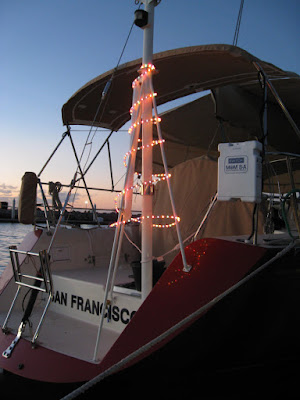La Posada (The Inn or The Shelter) festivities are a big deal here in Mexico. They take place during the nine days before Christmas, the number nine representing the nine months that Jesus spent in the womb, or the nine days journey to Bethlehem. There are organized Posadas in towns and neighborhoods, and there are also many La Posada parties held in private homes. These celebrations re-enact the journey that Joseph and Mary made as they looked for shelter.
This season I had the opportunity to go to a Posada Party at the home of a local couple with my neighbors Manny and Lola. My Spanish came in handy since the guests were a mixture of gringos and locals.
There was a big pot of hot Ponche on the stove; this was a sweet, hot punch filled with steeped fruit, spices and pieces of sugar cane. The longer it sits the sweeter it gets. Some people also add rum or other liquor to the Ponche.
 |
| Party guests enjoying our big vat of Ponche. |
After everyone got their sugar high from the cane-infused Ponche we started stuffing pinatas with candy. More sugar!!
 |
| Stuffing the pinatas with candy. |
Before commencing with pinata whacking all the guests divided into two groups for the Posada re-enactment. Half of the group were on the "inside"; they symbolized the innkeepers who would refuse, and then ultimately accept Mary and Joseph into their inn for shelter. The other half of the group were on the "outside", symbolizing Mary and Joseph requesting shelter. We all got copies of the La Posada song, we lit our candles, and then each group sang their parts.
 |
| "In the name of heaven we ask you for shelter..." |
After singing the La Posada song our hosts hung up the pinata. The traditional shape is a star with seven points. Each point symbolizes one of the seven deadly sins. I think the symbolism of whacking this pinata to pieces and then getting rewarded by candy is pretty obvious.
 |
| Guess who dealt the death blow to the pinata? |
After the pinata whacking our hosts started bring out the meal, but since it was 11:30 p.m. and long past Cruiser's Midnight (9:00 p.m.), Manny, Lola and I were yawning and so we thanked our hosts and headed back to our boats.
Album: La Posada
All pictures by Manny Fimbres
 |
| Cinnabar gets into the holiday spirit |
The rest of our December was filled with visiting a Santa's Village, socializing with friends, kiting in La Ventana, eating tamales, stocking up on seasonal Noche Buena beer, and listening to music.
 |
| Tom finds the last Noche Buena beer in the city of La Paz (after checking 5 stores) and buys them out, 14 cases. |
Dock neighbor Nancy on Shindig is a wonderful musician. She plays cello in the local orchestra and we enjoyed two nights of holiday performances, one with the youth orchestra and another with the adult orchestra.
 |
| Nancy, center, playing the cello. |
Our friend Conchita, the bartender at the marina bar, invited Manny, Lola, Tom and I to her house for tamales. It meant a lot to us that she invited us into her home, not to mention the tamales were DELICIOUS! She even gave us bags of tamales to take home.
 |
| Sylvia, Conchita and Lola in Conchita's home. |
Día de los Reyes (King's Day) is on 6 January and commemorates the day that the Magi (3 kings) brought gifts to the baby Jesus. In Mexico, it is this day that children traditionally receive their gifts. It's customary to eat a Rosca de Reyes cake (shaped like a wreath), and whoever gets the tiny baby figurine hidden in the cake gets to make tamales for everyone else on February 2nd, el Día De La Candelaria. I deliberately avoided eating any Rosca de Reyes cake because I didn't want to chance having to make tamales for a crowd.
Día De La Candelaria celebrates the appearance of the Virgin of la Candelaria in Tenerife at the beginning of the XV century. Celebrations in Mexico take place on February 2 and the "lucky" person who got the baby in their Rosca de Reyes cake gets to make tamales and atole (hot chocolate made with corn masa) for the party. These are both corn-based dishes; this tradition has pre-Hispanic roots since the date coincides with the native tradition of offering a corn blessing for the start of a new agricultural cycle.
This is the day I also celebrate my new resolution: No more tamales for at least a month!!
Album: Christmas in La Paz
 |
| (A belated) Feliz Navidad! |
